A tribute big as the Ponderosa
October 9, 2014
After years of navigating enough obstacles to prompt the patriarch on TV’s Bonanza to yell, “What in tarnation is going on down there?” Los Angeles County is poised to finish upgrades at Dan Blocker Beach in Malibu, though on a more modest scale than initially envisioned.
The $5.5-million project at 26200 Pacific Coast Highway included purchasing a sliver of land above the mile-long beach, where a scenic overlook is now being constructed, complete with picnic areas, parking spots and restrooms. The site also will feature, for the first time, a bronze plaque funded by fans and honoring the actor who played Hoss Cartwright on one of the longest-running and most beloved series in television history.
The overlook area will not provide direct access to the beach that bears Blocker’s name. Not only is the bluff extremely steep—30 feet high in some places—but the beach area directly below is too rocky for general use. However, beachgoers can walk onto the sand by entering at more accessible points north or south of the new overlook. Those new access ways also are being improved as part of the project.
The project should be substantially completed in time for a dedication ceremony on Nov. 14.
The late actors Michael Landon and Lorne Greene, who rose to fame as Little Joe and Ben Cartwright on Bonanza, bought and donated the beach to the state of California in 1979.
It was their way of honoring their costar and friend Blocker, after his untimely death at age 43 from a pulmonary embolism following what should have been routine surgery.
The state handed the beach over to the county in 1995.
It was designated “for public park and recreation purposes” but the public didn’t get much of a chance to enjoy it because neither the state nor the county could afford to install amenities.
In 2004, the state Coastal Conservancy awarded the county $700,000 to make the beach more accessible, but that covered only half of the price tag for improvements mandated by the Americans with Disabilities Act and various local zoning codes. The grant ended up being diverted to other, more shovel-ready projects.
Malibu City Council members, frustrated with the slow pace, sought to take over the project in 2011. But the county, which was shouldering the price tag for renovation, refused.
With no safe way to access the beach from the bluff, authorities erected an unsightly chain-link fence that discouraged, rather than encouraged, visitors.
“When we started, the site was empty,” said county Department of Public Works project manager Salim Sioufi, who oversaw the construction. “There was nothing on it.”
“Now, we’re building an area where people can sit and look at the ocean,” he added. “It’s going to be beautiful.”
The county eventually cobbled together funding from various sources, including money from the 3rd Supervisorial District, to build a space offering stunning views of the coast, picnic tables and trash receptacles, restrooms with an underground wastewater treatment system, and a parking lot with 15 spaces.
“The bluffs are very steep, so it was a very difficult place to do construction,” said Carol Baker, public information officer with the Department of Beaches and Harbors.
“We wanted to provide safe, accessible and beautiful open space but we also needed to appropriately address the challenges presented by the natural environment,” she added.
Although Bonanza, which ran for 430 episodes between 1959 and 1972, has long been off the prime time network schedule, it still has legions of fans. So does Blocker, who despite his intimidating physique—6’4”, 300-plus pounds—played the warm but gullible middle Cartwright brother who once mistook diminutive circus performers for leprechauns.
In real life, however, the Texas-born Blocker once worked as an elementary and high school English and drama teacher, and was the only member of the cast with a master’s degree. He also tried to pursue a Ph.D. until acting took up all of his time.
Carla Ledford, 56, has been watching the show ever since she was a child and continues to do so, when she’s not working in marketing for a university in Ohio.
She and fellow fans got the idea for a plaque after struggling to locate Dan Blocker Beach during a visit to Malibu in 2004.
“There was just wasn’t anything there,” Ledford said. “We drove up and down trying to find it when we finally saw a faded lifeguard tower where we could just make out the name ‘Dan Blocker Beach.’ ”
“I mean, it’s a nice beach, but…we just thought it needed something,” she added.
They took up a collection through the fan fiction website Bonanza Legacy and received donations from fans as far away as Australia, England, France, and the Netherlands.
Ledford said because she’s literally been waiting 10 years to see the plaque installed, she’s considering postponing foot surgery and flying from Ohio to California to attend the dedication ceremony.
“I’m seriously thinking about it,” Ledford said.
Posted 10/9/14
Trouble at sea
September 18, 2014
A punishing heat wave sent thousands of people fleeing to the beach this week, but many who tried to cool off in the ocean found themselves in hot water instead.
The Los Angeles County Fire Department’s Lifeguard Division saved more than 1,000 swimmers and surfers swept up by rip currents and other hazards over a five-day period when temperatures peaked at 107 degrees in the San Fernando Valley.
This brought the lifeguards’ total number of rescues up to about 12,000 since January. That’s their third highest tally ever in a single year — with three months still remaining in 2014.
Acting Chief Lifeguard Steve Moseley attributes the spike to a rare confluence of factors: A surge in beach attendance driven by extended periods of unseasonably hot weather, more frequent occurrences of high surf and a warmer ocean.
“All of these contributing factors have combined to create one of the busiest years in recent memory for the Lifeguard Division,” Moseley said.
To date, beach attendance has hit 61 million — well past the 20-year average of 54 million and on pace to exceed last year’s 71 million.
“It’s been so hot inland that everybody’s coming to the beach, even on a Tuesday or a Wednesday,” said Ocean Lifeguard Specialist A.J. Lester. “And because ocean temperatures are warmer, everybody’s staying in the water all day long.” (Tips on staying safe on the beach are here.)
Jet Propulsion Laboratory climatologist and oceanographer Bill Patzert said swimmers and surfers have been particularly vulnerable to being swept away by rip currents, and falling into deep grooves on the ocean floor.
He explained several hurricanes and tropical storms spawned by El Nino conditions in the equatorial Pacific scored the ocean floor, leaving uneven contours.
“The county’s south-facing beaches have been hit with big waves, almost week after week,” Patzert said. “Hurricane Norbert is breaking up, but we have yet another one forming now.
“Because these tend to change the configuration of the ocean bottom,” he added, “people very easily can get into water over their heads in these rip currents.”
Lester said the county employs 200 full-time and 700 part-time lifeguards and has “needed every one of them.” He himself rescued 18 people in a single day last spring, including a pair of boogie-boarding teenagers swept away by rip currents.
“The sister was screaming blood-curdling screams because her brother had fallen off his board and, basically, he was drowning,” Lester said. “I wrapped them around my rescue can but a wave slammed us down to the bottom, and when we got back to the surface, we were all spitting up water.”
Moments after he brought the siblings ashore, he had to dive back in for yet another double rescue. “Then I returned to my tower and parked my truck, but before I could even dry off, we had to pull more people out,” Lester said.
“It’s gotten to the point sometimes when we’re going from one rescue to the next,” Lester said. Still, he added, “There’s nothing more rewarding than completing a rescue, coming back to the beach, and watching those kids run back to their parents, and they’re all hugging each other, and thanking us.”
Section Chief Chris Linkletter said lifeguards also have racked up 1 million “preventions.”
“This means we have prevented that number of people from either becoming rescues or getting into a hazardous situation,” she said.
Amid all the rescues, however, there also have been mishaps.
On Monday, a lifeguard driving a pickup truck back to his tower accidentally ran over a sunbather, who survived but sustained fractures and lacerations to her internal organs.
It was the second such accident this year. In May, another sunbather was hit by a county beach maintenance vehicle.
Posted 9/18/14
Shark bite opens debate
July 10, 2014
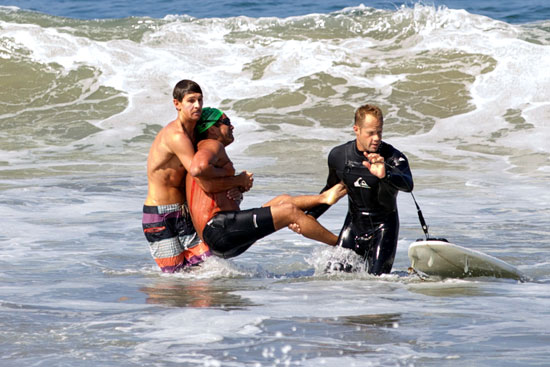
Steve Robles is pulled from the Manhattan Beach surf after his encounter with a snagged white shark.
The fisherman is off the hook. But his headline-grabbing behavior on the Manhattan Beach pier—when he snagged a young great white shark that thrashed and ended up biting a swimmer—is still churning up debate over how best to protect the beach-going public.
Manhattan Beach has quickly moved to ban all fishing from the pier for up to 60 days, although the California Department of Fish and Wildlife is weighing whether the city may have overstepped its authority on the state-owned pier. Meanwhile, Los Angeles County lifeguard officials have begun refining a new policy to create buffer zones between swimmers, surfers and the young sharks that increasingly are making Manhattan Beach their home before they head to deeper waters.
What’s more, officials now are being forced to confront an undercurrent of hostility that for years has strained relationships around the 94-year-old concrete pier, the oldest in California.
The sensational incident during the July 4th weekend—mistakenly characterized in early news reports as a shark attack—has exposed long-running complaints by surfers and swimmers that some pier fishermen have been endangering them. Among other things, they accuse fishermen of illegally “chumming”—dumping buckets of fish guts off the pier—to attract sharks.
“Tempers have been flaring,” said Los Angeles County Lifeguard Captain Kyle Daniels, who’s stationed in Manhattan Beach. “We do our best to separate the groups but it’s a dynamic situation. This goes back years.”
The Saturday incident brought it all to the surface, generating a wave of national news coverage and social media finger-pointing—most of it aimed at the fisherman and his friends, who were bombarded with allegations of animal cruelty and human indifference. The group was caught on video laughing and joking in the moments before they realized that a swimmer had been hurt by the distressed shark on the end of their high-gauge line. As of Thursday, the video had more than 1.4 million views.
According to witnesses, fisherman Jason Hagermann had been battling with the 7-footer for 45 minutes. The fish surfaced just as a group of distance swimmers passed while training for an upcoming pier-to-pier event. The victim, Steve Robles, can be heard on the video wailing as other swimmers rush to his rescue. Robles, a former L.A. County lifeguard himself, suffered serious but non-lethal gashes under his arm and along his side.
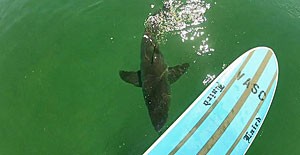
Juvenile great whites have been feeding in Manhattan Beach "like infants at an all-you-can-eat buffet."
Under state and federal law, it’s illegal to target great whites. If one gets hooked, then the line must be promptly cut. Hagermann told Fish and Wildlife investigators that he hadn’t been fishing for great whites and that he was afraid to cut the line while so many swimmers were nearby. With no evidence to contradict him, an agency spokeswoman said, no charges were filed.
Still, county lifeguard Daniels and others familiar with shark behavior insist the fish would never have bitten anyone had it not been fighting for its life. “If you lassoed and dragged a bear through a crowd,” he said, “I’m sure someone would get hurt.”
Daniels also said that the exceptionally strong wire-like line the fisherman was using posed a far greater danger to public safety than the juvenile shark. Had the fish quickly darted across and underneath the group of swimmers, “the line would have cut through to the bone.”
Laurie Jester, acting director of community development for Manhattan Beach, said the 60-day ban on pier fishing will give officials an opportunity to determine whether new restrictions should be imposed to avert these kinds of preventable risks.
“There’s a public safety concern with fishing on the pier,” she said, “and we want to make sure we’re covering all our bases, consulting with all the right people.”
The Los Angeles County Fire Department, which oversees lifeguard operations, has also moved in recent weeks to protect swimmers and surfers from potential harm.
Chief Daryl Osby said the department introduced a policy this summer to create “exclusionary zones” 300 yards into the water when sharks bigger than 8 feet are spotted because, unlike juveniles, these animals “can sometimes exhibit aggressive behavior, representing a public threat.” Osby said the department, in consultation with scientists at the Monterey Bay Aquarium, has developed a public education program “so beachgoers can become aware of the environment and habitat they’re about to enter.”
That habitat, scientists and others say, is increasingly a shared one, as rising numbers of young white sharks are taking up temporary residence at the popular El Porto surfing area, at Manhattan Beach’s northern end.
As a result, “the curious and the YouTube seekers” are boarding all sorts of crafts for a view of the sharks as they feast on the bay’s plentiful offerings, “like infants at an all-you-can-eat buffet,” said Manhattan Beach’s ex-mayor, Steve Napolitano, now a senior aide to Los Angeles County Supervisor Don Knabe, whose district includes the South Bay.
International big-wave rider Alex Gray, who’s also an avid fisherman, has been playing in the Manhattan Beach surf since he was a kid. He resents the human intrusions into the young white sharks’ habitat.
“Give the animals the respect they deserve and allow them to be at home,” he said the other day, as he looked out across the Pacific. “What if I walked into your house, took a picture of your family eating dinner and then walked out? Give respect, get respect. Just let them be.”
“I’ve traveled the world and I’ve never once had a bad encounter with a shark,” he added. “If I see a shark, I give it its area. I would never paddle up to it for a picture.”
Gray, 28, said the one thing that “breaks my heart” about the Manhattan Beach incident is that “kids might now be afraid to go into the ocean…I love this community more than anything. It hurts me when I see negativity that doesn’t need to be there.”
Posted 7/10/14
New beach chief rides the waves
May 8, 2014
Gary Jones’ new job as director of the Los Angeles Department of Beaches and Harbors is a little like going surfing while wearing a tie. It’s an ongoing attempt to marry L.A.’s freewheeling beach culture with business concerns such as permits, parking, environmental impact and—always—budget.
Access to L.A. County’s beaches remains an emotional issue for residents, many of whom treasure days at a local beach among childhood memories, Jones says. The 45-year-old Englishman’s first visit to Southern California took him to Venice’s Muscle Beach. “Venice Beach and the L.A. lifeguards are iconic, in part from Baywatch. Surfing, the beach life, the fire pits —that type of culture is very much transmitted around the world,” Jones says.
Jones’ Marina del Rey office affords a picture-postcard view of blue sky, seagulls and sailboats. Hailing from the English “rowing town” of Bedford, he loves to observe rowing teams from UCLA and Loyola Marymount University take on the chilly early mornings. On his desk are the less enticing realities of the gig: The first proposed increases in fees affecting the public since 2009 are set to come before the Board of Supervisors next week. They include increases in summer parking fees, beach permits for organized recreational classes such as yoga, youth camp expenses and dry storage of trailered boats.
And if past experience is any guide, those kinds of changes—ranging from new meet-up rules to a misunderstood Frisbee policy—can kick up a lot of sand.
“In the dynamics surrounding the county’s operation and ownership of beaches and the coastline, there are some very interesting forces at play,” adds Jones, who served as interim director for eight months before stepping into the permanent post on April 15. “Underpinning it all is that overwhelming sense that this is something the public should have access to. Some people think that access translates to free, or as low cost as possible. Or if I want to join 50 or 100 of my closest friends and train for a triathlon, I can do that.”
Standing out among the currently proposed increases are a new fee for the annual senior parking pass ($25) and substantial hikes for five-day youth camps, some of which have recently been on hiatus. Sailing and surf camp fees would go up sharply (sailing rising from $165 per participant to $375, surf camp from $165 to $300). Jones notes that the department continues to look for ways to cut operating costs so fees may end up being lower than proposed. He adds the department will still give financial assistance to needy participants.
Jones says the department is also looking to expand the county’s popular water taxi service that transports the public to concerts and events at Chace Park, along with other stops including Fisherman’s Village and Mother’s Beach. This summer, the service is slated to begin June 19.
Jones, who moved to the U.S. in 1998, began his Southern California career managing assets for the city of San Diego. He came to Los Angeles County’s beaches and harbors department in 2009. Jones stepped into the interim director position when then-director Santos Kreimann became acting county assessor after the elected assessor, John Noguez, was placed on leave pending a trial on corruption charges.
With the approach of Memorial Day and the traditional opening of summer beach season, Jones says his foremost concerns include the continuing redevelopment of Marina del Rey (money from private development flows into the general fund, he says) and beach maintenance for the summer onslaught (sand grooming, restroom upgrades, parking lot re-surfacing).
Also at the top of the list: A greater social media presence and a more user-friendly website to provide up-to-the-minute information on parking and rates, easily accessible by smart phone or tablet.
Jones adds that some beaches require a delicate balance between humans and wildlife. Visitors don’t always understand the needs of the grunion or the Snowy Plover, or why the “rack line” of seaweed left behind by the tide represents an important ecosystem, not just a source of odor and pesky sand flies. “We have 50 million plus people using our beaches every year —how do you balance that with being a good environmental steward?” muses Jones.
And why did Jones take on this balancing act? “No municipal department has the blend of what this department is responsible for,” Jones asserts.
“I don’t think I could have been satisfied churning out commercial real estate deals or office deals,” he says. “It’s very rewarding when you see a project come together and you see people enjoying it, the impact it has on a community. I think that’s what makes me tick.”
Posted 5/7/14
The state of the shark
January 29, 2014
Last July at the end of a long beach day, a Los Angeles County Sheriff’s helicopter spotted a 6-foot-long great white shark off of El Porto Beach. The copter’s loudspeaker was so clear that some South Bay locals heard it at home in their kitchens: Exit the water immediately.
To authorities in the air, it made perfect sense to issue a warning. Down on the sand, however, the sighting was familiar to county lifeguards—a baby great white feeding on small fish and stingrays, off the coast of a county that hasn’t seen even a hint of shark trouble in 25 years.
More broadly, however, the incident underscored the recent rise in local shark encounters, and the lack of a clear, uniform local policy on how to handle them. That’s why the Los Angeles County Fire Department’s Lifeguard Division will be hosting a symposium at Dockweiler Beach on Friday for local public safety personnel, elected officials and researchers. Organizers say the event is intended partly to work toward a policy consensus and partly as an opportunity to examine the state of the great white shark on beaches here.
“To my knowledge, no one has ever been fatally bitten by a great white in Los Angeles County,” says Chris Lowe, a marine biologist who leads the Shark Lab research center at Cal State Long Beach. (A suspected 1989 attack off the coast of Malibu was handled by Ventura County and never confirmed.)
“But the sightings have gone up, and the numbers seem to be going up, too,” Lowe says. “So this is partly to bring water safety people up to speed.”
Great whites are the best known of about ten shark species that can be found off the Southern California coastline, Lowe says, but they generally prefer habitats that are rockier and colder. Female sharks are believed to migrate to this area to give birth to their offspring, which may be why the sharks that seasonally show up in our waters tend to be juveniles under 12 feet, Lowe says.
Because great whites are hard to tag, he says, their numbers are hard to pin down.
“But their populations do seem to be increasing,” he says. Theories range from cleaner water and recovering fisheries to the fact that, as a candidate species under the state Endangered Species Act, great whites are protected in California, so it is illegal to catch and kill them.
That, however, hasn’t kept thrill-seekers and shutterbugs from seeking them out in numbers sufficient to prompt another theory—that there aren’t necessarily more great whites in the water, just more cameras.
Last year, a bumper crop of SoCal shark encounters showed up on YouTube, from a viral helmet-cam clip of a young great white swimming under an audibly nervous paddleboarder to footage of a surf fisherman reeling in a 3-year-old great white near San Onofre.
“You have to be prudent,” Lowe says. “Even though most of those sharks off Manhattan Beach were babies, if someone chases and corners them, they’ll do what any animal would if it feels threatened—it will attack you. It’s generally not a good idea to chase a shark around.”
Though the few shark attacks that have occurred south of Point Conception have been in other counties, Lowe says that he can understand the desire for local consensus on policy.
“In Hawaii, for instance, we trained lifeguards and helped them develop procedures based on things like the size of the shark, whether it appears to be aggressive and whether there have been indications that people or animals have actually been bitten,” he says.
“So at this symposium, we’ll be talking about what can be done, whether to close the beaches or post notices or just pass the word to other lifeguards. And some areas may already have some of those policies in place.”
Dan Murphy, ocean lifeguard specialist for the Los Angeles County Fire Department’s Lifeguard Division, notes that local beaches fall into a variety of jurisdictions. Most are guarded by the county, but some have state or local personnel guarding the waves.
In years past, lifeguards say, the lack of a single local policy on great whites hasn’t mattered much because so few attacks happened. Baby great whites, they say, have been known to cruise right under a surfer and pose no danger.
“But that’s not to say that one of those might not take a left turn one day and chomp a stand-up paddler,” says Lifeguard Capt. Kyle Daniels, who notes that San Diego has a well-developed response policy for shark sightings. “Outside Santa Monica Bay, I’ve seen sharks eating sea lions—not at highly populated beaches, but still.”
Tom Ford, director of marine programs at the Santa Monica Bay Restoration Commission, says it is important for coastal stakeholders to educate each other as they learn more about co-existing with an important predator.
“This isn’t some scene out of ‘Jaws,’ ” he said. “These animals are part of a healthy environment and we want them to go through the course of their day without any harm to their natural movement.”
Posted 1/15/14
Surf’s up—and rescues, too
January 29, 2014
Bone-crushing waves in Palos Verdes. Lookie-loos being washed off the rocks in Abalone Cove. Kids getting caught two and three at a time in rip tides.
It’s been a gnarly winter on Southern California’s coastline so far.
Faced with a triple threat of unusually warm weather, long holiday weekends and, most recently, high surf advisories, Los Angeles County lifeguards have been hustling to keep up with a decidedly unseasonal spike in attendance at the beach.
“I’ve been a lifeguard since 1986,” marvels Los Angeles County Lifeguard Capt. Tim Arnold, “and this is by far the busiest December and January I’ve had in my career.”
January attendance at county beaches is almost twice what it was last year, with nearly triple the number of rescues, lifeguard figures show. Spurred by heat waves that have sent temperatures into the 90s in some parts of Southern California, beach-goers have hit the sand more than 2.6 million times this month, and lifeguards have had to make more than 111 rescues.
That’s not counting the thousands of people who have had to be warned away from dangerous water, or the hundreds who have gotten into enough trouble to require medical attention. And January isn’t over yet.
“This year’s Martin Luther King holiday was probably the biggest winter day I’ve ever seen in my life,” says Arnold. “Between Manhattan Beach and Hermosa Beach, we had, like, 20 rescues.”
Complicating the job has been a swell produced by a storm system over the central Pacific that has been generating 10- and 12-foot waves along parts of coastal Southern California. South Bay beaches have been hardest hit, but county lifeguards also have felt it in Santa Monica and Malibu.
“It’s been tough for the guys sitting on the towers,” says Lifeguard Capt. Tim McNulty, who works the beaches from Big Rock in Malibu to Nicholas Canyon. At Zuma Beach, he said, only five of eight stations could be manned on MLK weekend because so many people on the “recurrent” list of part-time seasonal lifeguards were away at winter jobs or college.
“Everyone was on the edge of their seat with this surf and all those people,” says McNulty. “And we had hired everyone who was available on the recurrent list. We were calling people out of the blue.”
Lifeguards say rescues have been routine in nature, but summer-like in volume, with an inordinate number of novice surfers in over their heads.
“A lot of them are people on these boards called Wavestorms, that they sell at Costco for like $100,” says Arnold. “They’re like soft surfboards, and they essentially put a board into the hands of anyone who wants one, and these people are coming down and getting caught in situations they shouldn’t get caught in.”
Lifeguard Capt. Chris Linkletter, who also works in the South Bay, says daredevils and curiosity seekers have also been a problem.
“We had a surfer who broke his leg at the bottom of the Palos Verdes cliffs this week, and two people who were washed off the rocks in Abalone Cove,” she says. “We had some ‘blitzes’, too, where two or more people have to be rescued, usually from rip currents. Everybody’s seeing the high surf advisory on the Weather Channel and we’re having a lot more people who want to come out and take a look.”
Linkletter says she’s been advising all who will listen to remember a few basic safety tips for visiting the beach.
“Don’t swim alone,” she says. “Stay near an open lifeguard station. Keep a safe distance from piers and rocks, and obey the signs and warnings. And always check with the lifeguard to make sure conditions are safe.”
Lifeguards say they’re hoping for some relief this weekend, when Super Bowl parties are likely to keep at least some people at home.
“Other than that, I’m just waiting for rain,” says Arnold. “Though we don’t seem to get any of that anymore.”
Posted 1/29/14
Where summer lingers after Labor Day
August 29, 2013
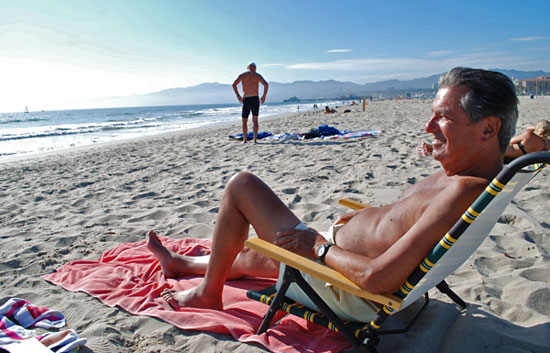
Lance Wichmann says he finds serenity on the Santa Monica sand when the crowds disappear in September.
Lance Wichmann’s playpen was a patch of warm sand at the foot of Ocean Park Boulevard. His family’s Santa Monica house was less than a block from the beach, and his mom started carrying him there before he could walk.
Today, more than seven decades later, you can still find Wichmann at that same spot, sunning himself in retirement, a few tentative steps from the shoreline home that remains in the family. He knows just about everything there is to know about beach life around lifeguard station 26, which draws some of the heaviest crowds in Southern California during June, July and August.
And one of the things Wichmann knows (besides the best body-surfing breaks) is this: although Labor Day on Monday represents the unofficial end of summer, it’s the beginning of a two-month-long, locals-only holiday, when ideal conditions come to the beach—but not the people. The truth is that, unlike other coastal areas throughout the nation, air and sea temperatures here drop an average of only a few degrees between Labor Day and Halloween.
“It’s so much quieter,” the 72-year-old former insurance executive said of LA.’s extended summer season of September and October. “I know Santa Monica is a tourist town, but I like it when I can come down here at low tide, when the kids are back in school, and walk along the sand by myself. To me, it’s spiritual.”
Let the rest of the country use Labor Day as its farewell to summer. Here in L.A., savvy beachgoers know that the occasion actually signals “the start of the beach season,” joked county lifeguard Captain Kyle Daniels, who oversees community services and youth programs. In September and October, he says, “the days are warmer, the winds are lighter and the views of Catalina are better.”
And the crowds are so much thinner that, after Labor Day, lifeguard stations are staffed every mile or more, rather than every 200 yards. “I don’t want to say it’s easy,” Daniels said of the workload that comes with reduced staffing levels. “But it’s less intense.”
There are other signs in the bureaucracy that, come this weekend, vacationers are about to vanish.
Carol Baker, a spokesperson for the Department of Beaches and Harbors, offered this post-Labor Day tidbit: the agency’s facilities and property maintenance division, which oversees beach restrooms, has just received its last major order of toilet paper and expects to use only 400 cases during the winter months, compared to as many as 1,000 cases during the summer.
When asked about her own favorite beach month, Baker declined to pick a favorite. “I know this will sound like a bubbly cheerleader, but every month at the beach is my favorite.” That said, she acknowledged that “some of the best summer days are in the fall.”
And that may be particularly true this year because of the fog that has shrouded the coastline during August—or, as Baker calls it, “Fogust.” This week saw some of the best weather of the summer, with the weekday visitor count already way down.
“In July, you could barely see the sand, there were so many people,” lifeguard Chris Smith said on a brilliant Tuesday afternoon as he kept watch over a couple of body boarders and surfers not far from where Wichmann was working on his tan. “The crowd is non-existent right now.”
“It’s a secret,” he added, “that the beach season is still going strong in October.”
Up along the bike path, meanwhile, business was slow enough at Perry’s café that chef Robin Hathaway could take a break to talk to a visitor about the post-Labor Day rhythms. “All the locals come down to reclaim their spots,” Hathaway said. “People have their routines. It’s more health and fitness oriented—running, riding, yoga, skate boarding, surfing.”
Of course, if the café had its way, she said with a wink, “summer would last forever.”
Posted 8/29/13
Beyond “Baywatch”
August 1, 2013
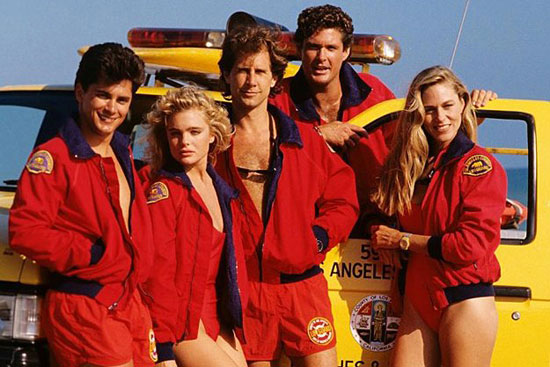
“Baywatch” made county lifeguards into global sex symbols—and made them leery for years about celebrity.
The Los Angeles County Fire Department is rarely surprised when Hollywood comes knocking. After all, their firefighters and lifeguards have some of the more exciting real-world jobs here in Tinseltown.
But for more than a decade, the department has shied away from film depictions.
“Our image is very important to us,” says Capt. Thomas Richards of the department’s public information unit. And, he says, shows like “Baywatch”—which turned L.A. County lifeguards into global eye candy in the 1990s—left county taxpayers, as well as some lifeguards, feeling burned.
Now, however, the department is dipping a cautious toe back into the show biz waters with a proposal to streamline the approval process for film requests.
Scheduled for consideration next week by the Board of Supervisors, the plan would let the department contract on its own with film production companies to do the limited filming necessary to create TV pilots, “sizzle reels” and other supporting material for pitches to the county.
The idea, Richards says, is to give fire officials—and ultimately the Board—a fuller sense of how county employees might be affected by or depicted in a proposed film or series while easing the frustration of producers, who often get a flat “no” from the department or wait weeks or months for an answer. Such filming would not be for public consumption, and the Board would retain final approval for any use on film of the department’s image, personnel, facilities or equipment.
“If we can show firefighters and lifeguards in a positive light, that’s a good thing, and these requests come to us all the time,” says Richards. But, he says, the current approval framework can be cumbersome and lengthy, and the requests are often time-sensitive.
That’s an understatement, says Bud Brutsman, chief executive officer of Brentwood Communications International, Inc., a North Hills production company that came to the county six months ago with a request to film county lifeguards for a reality show proposal featuring Venice Beach.
Brutsman says the show, operating under the working title “Venice 24/7”, has been commissioned by the Travel Channel as a West Coast spinoff of its successful “Airport 24/7: Miami,” a reality show about Miami International Airport. “The concept is to follow all aspects of the city—police, HazMat guys, lifeguards. For Venice, it’s a very positive thing.”
As part of the deal, he says, he has to shoot a so-called “sizzle reel”—a 2-to-3-minute collection of scenes that functions both as a preview and as proof that the producers have the access to generate a whole series. To do this, he has had to seek permission to film from both the City of Los Angeles and the county, which share responsibility for the community’s various municipal services.
But while the city services were shot in a matter of weeks, he says, he’s still awaiting permission from the county, which provides the community’s lifeguards.
Richards says that’s partly because the department decided to seek the policy change before responding. But, he says, decisions on filming, even for small proposals, currently require Board approval, which can be time-consuming.
The department spokesman adds that county lifeguards actually like the Venice project, viewing it as an opportunity to show real people performing a real public service. That’s a far cry from the way the department has viewed past TV depictions.
“Baywatch was very successful—for the producers of Baywatch. And that’s something that still comes up,” says Richards, noting that little revenue from the series ever found its way into county coffers, and that lifeguards came away feeling objectified by the show’s slow-motion scenes of god- and goddess-like actors loping down local beaches.
“Our lifeguards are the best in the business,” he says. “And the county got very little from that experience.”
Brutsman, the producer, hopes to convince the department that his show will be different. Still, he notes, delays and distrust just make it harder to do show business in the industry’s backyard.
“I gotta bear the cross for Baywatch?” he jokes. “”Hey, I didn’t like that show either! But if it helps, we can leave our slow-mo camera at home.”

A proposed reality show about Venice Beach has been waiting for months to shoot a 3-minute “sizzle reel.”
Posted 8/1/13
Group swim meetup? Better get an OK
June 6, 2013
For the L.A. Tri Club, a Santa Monica-based triathletes organization, there are few better places to train for their running, swimming and bicycling contests than Malibu’s Zuma Beach.
But last summer, they hit choppy waters.
“A member was posting on our website, saying ‘I’m going to swim on Saturday at 8 a.m., come along,” club president Paul Hekimian remembers. “But when we got out there, the lifeguards were saying we needed to pull a permit.”
The problem? Thanks to the power of social networking, there was a crowd in the ocean—a phenomenon that has been happening with ever greater frequency.
“It’s something we’ve seen for a while on the land, with people who train for marathons and so forth,” says Kerry Silverstrom, chief deputy director of the Los Angeles County Department of Beaches and Harbors. “But now we’re seeing it more and more with organized water activity.
“We want to make sure that we know when these groups are coming, so they don’t interfere with ordinary beach access or something we’ve scheduled, and so we can make sure that they’re safe.”
That’s why the Board of Supervisors this week made some adjustments to the county’s policy on beach permits for organized summer activities at county owned or operated beaches, stretching from Nicholas Canyon above Malibu to White Point/Royal Palms beach along the Palos Verde penninsula. The only exemptions are for city-managed beaches in Santa Monica and Hermosa.
In years past, the only organized, regularly occurring activities allowed during the busy summer beach season were those conducted during business hours on weekdays by groups such as surf or day camps that bid on specific locations as part of a competitive process. Others—such as, say, big groups of swimmers who wanted to work out together—typically were denied summer permits by Beaches and Harbors or turned away if authorities caught them, even when the beach was less busy.
But in the last couple of years, Silverstrom says, demand from water sports enthusiasts and fitness groups have intensified to the point that the department decided to expand its policy. Permits will now be available for regular gatherings of groups such as swim clubs, triathlete teams and paddleboard meetups, as well as for organized summer recreation in the early mornings and evenings.
But the new rules come with a cost that’s unlikely to put some applicants in a sunny mood.
Like other groups now using the beach, they’ll have to pay a $200 administrative fee (click here for an online application), produce proof of liability insurance and reimburse the county for the cost—about $50 an hour, on average—of any extra lifeguards.
There is no size threshold for water activity groups, partly, officials say, because most of the water-based crowds have sprung from social networks, which tend to produce a variable turnout.
“Someone on Facebook will want to meet up for yoga on paddleboards, and one week 12 people will show up, and the next week there’ll be two,” says Beaches and Harbors spokeswoman Carol Baker. “But whatever the size, if something happens, the lifeguards are the first responders and have to know who’s out there.”
The fine-tuning comes two years after an overhaul of Beaches and Harbor’s permitting system, which is only now being rigorously enforced as grace periods have ended and a team of code enforcement officers has come online.
Beach users have mixed reactions. The off-peak permit decision delighted Sarah Tiefenthaler, whose standup paddleboard yoga class, YOGAqua, had to move this summer because she lacked a permit to continue operating in Marina Del Rey on weekends.
“It’s wonderful to hear that there’s even a glimmer of hope,” Tiefenthaler says, adding that if she can get back into her old Mothers Beach location, she won’t mind the permit fees.
Meetup groups are less sanguine, however.
“I think this is murky,” says Hekimian of L.A. Tri Club. Though scofflaws can be fined from $100 to $500 for gathering without a permit, he notes, social networks like his have no clear lines of responsibility.
“It’s like a member of Facebook saying, ‘I’m going for a workout, who wants to join me?’” he says. “If that member doesn’t get a permit, who gets the bill? Facebook?”
Beaches and Harbors officials say that no group gathers en masse unless someone’s organized it, and that they don’t care who pays as long as someone gets a permit.
“When 30 people jump in the water for a swim at seven in the morning, it’s really important that lifeguards be there,” says Baker, who adds that “some of these meetup groups say they’re not organized and then you go online and see that they are.”
As the new rules settle in, eight code enforcement officers will be patrolling the beach this summer with an eye out for groups that appear to be organized.
“We’ll issue them a flyer the first time we meet them, and tell them that if they’re conducting a business or an organized activity, they need a permit,” says Vivian Sanner, who is handling beach code enforcement at the department.
“If they say, ‘No, we’re just a bunch of friends,’ we’ll let it go the first time. But if we see them again, same time, same place, we won’t be as nice.”
Posted 6/6/13




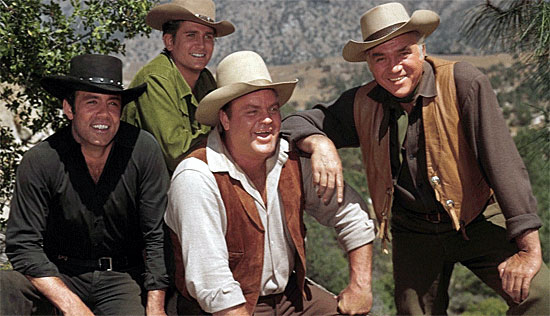

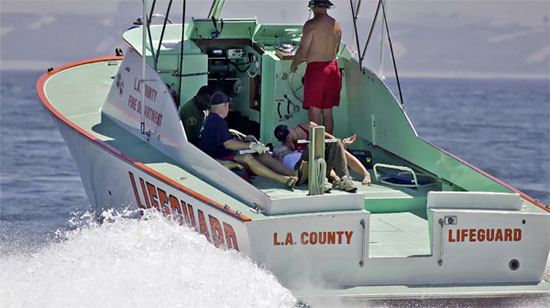
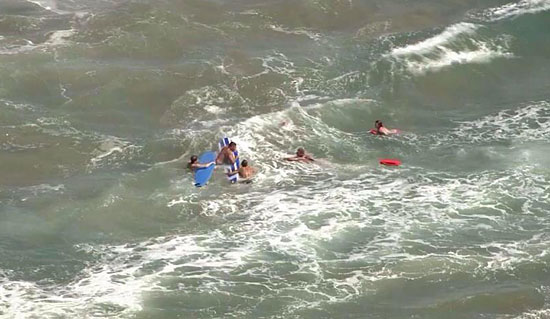
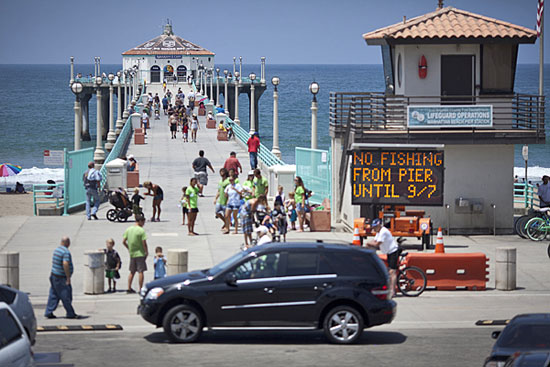
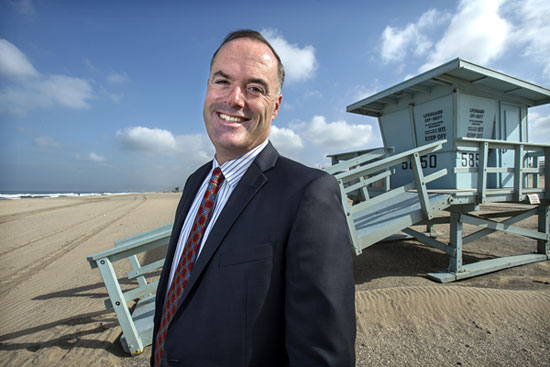
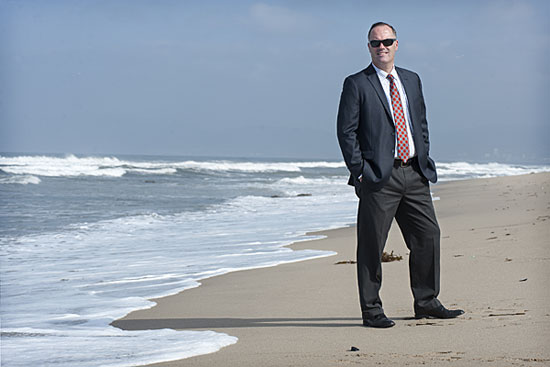
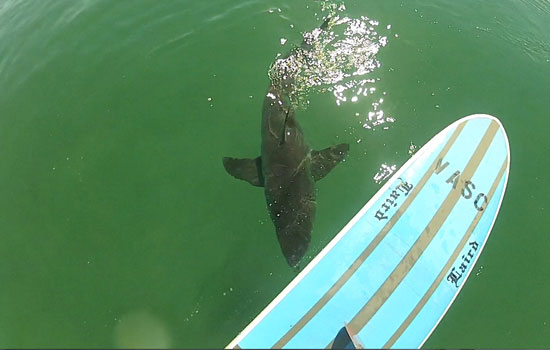
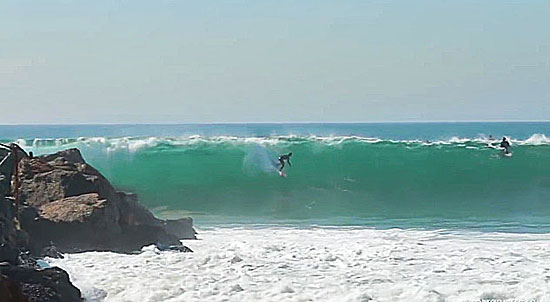
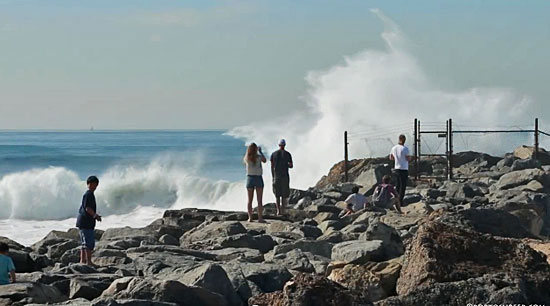
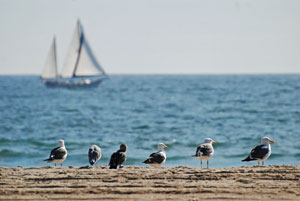
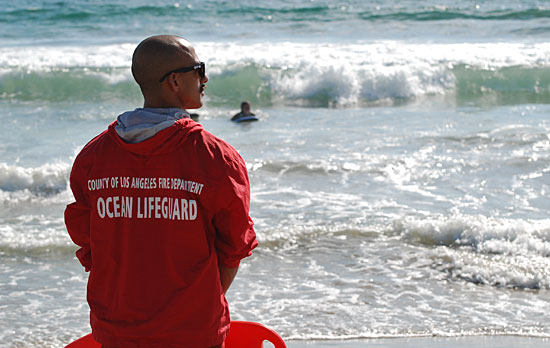
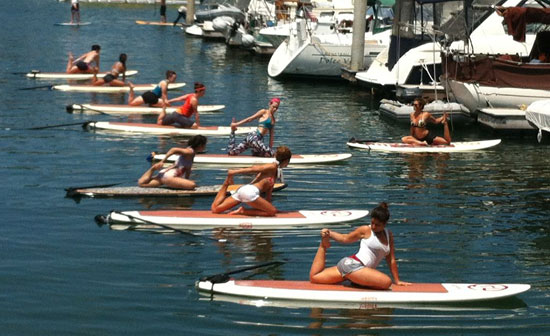








 405 bridge work causes a stink
405 bridge work causes a stink

